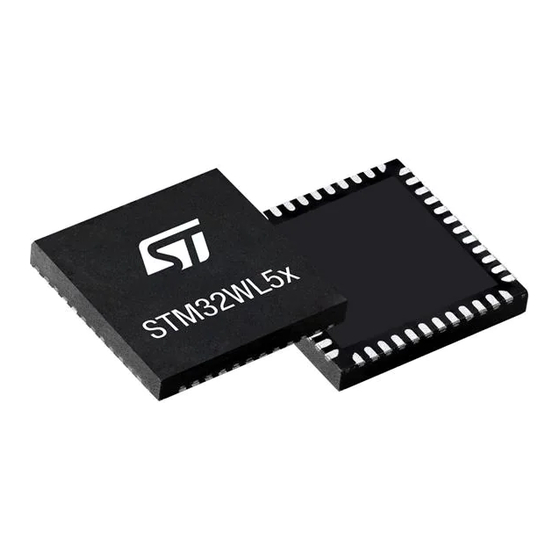
ST STM32WL55JC Manuals
Manuals and User Guides for ST STM32WL55JC. We have 1 ST STM32WL55JC manual available for free PDF download: Reference Manual
ST STM32WL55JC Reference Manual (1454 pages)
Advanced Arm-based 32-bit MCUs with sub-GHz radio solution
Brand: ST
|
Category: Microcontrollers
|
Size: 29 MB
Table of Contents
-
-
Glossary61
-
CPU2 Boot66
-
SRAM Erase67
-
Introduction72
-
Interrupts86
-
Empty Check100
-
-
Introduction118
-
RSSLIB Functions118
-
FLASH Interrupts128
-
FLASH Registers130
-
(Flash_Ipccbr)145
-
(Flash_Srrvr)151
-
Transmitter158
-
Receiver159
-
Rf-Pll160
-
Lora Modem162
-
Lora Framing164
-
FSK Modem166
-
Generic Framing167
-
MSK Modem167
-
BPSK Modem169
-
BPSK Framing170
-
Calibration Mode173
-
Sleep Mode173
-
Startup Mode173
-
Standby Mode174
-
(Subghz_Paocpr)222
-
Power Supplies229
-
CPU2 Boot240
-
Low-Power Modes242
-
Run Mode250
-
Table 47. Lprun251
-
Sleep Mode253
-
Stop 0 Mode255
-
Stop 1 Mode257
-
Stop 2 Mode258
-
Standby Mode260
-
Shutdown Mode262
-
PWR Registers264
-
PWR Register Map284
-
Power Reset287
-
Reset287
-
System Reset287
-
Clocks289
-
PKA SRAM Reset289
-
HSI16 Clock295
-
MSI Clock295
-
Pll296
-
LSE Clock297
-
LSI Clock298
-
SPI2S2 Clock300
-
ADC Clock301
-
RTC Clock301
-
Timer Clock301
-
True RNG Clock302
-
Watchdog Clock302
-
Is Not Used835
-
Preloaded)903
-
(Tim16/17)935
-
(Max T IDLE = 50 Μs)1092
-
(M Bits = 00)1151
-
(M Bits = 01)1152
-
(M Bits = 00)1153
-
FIFO Disabled)1169
-
FIFO Disabled)1233
-
Figure 368. I1291
Advertisement
Advertisement
